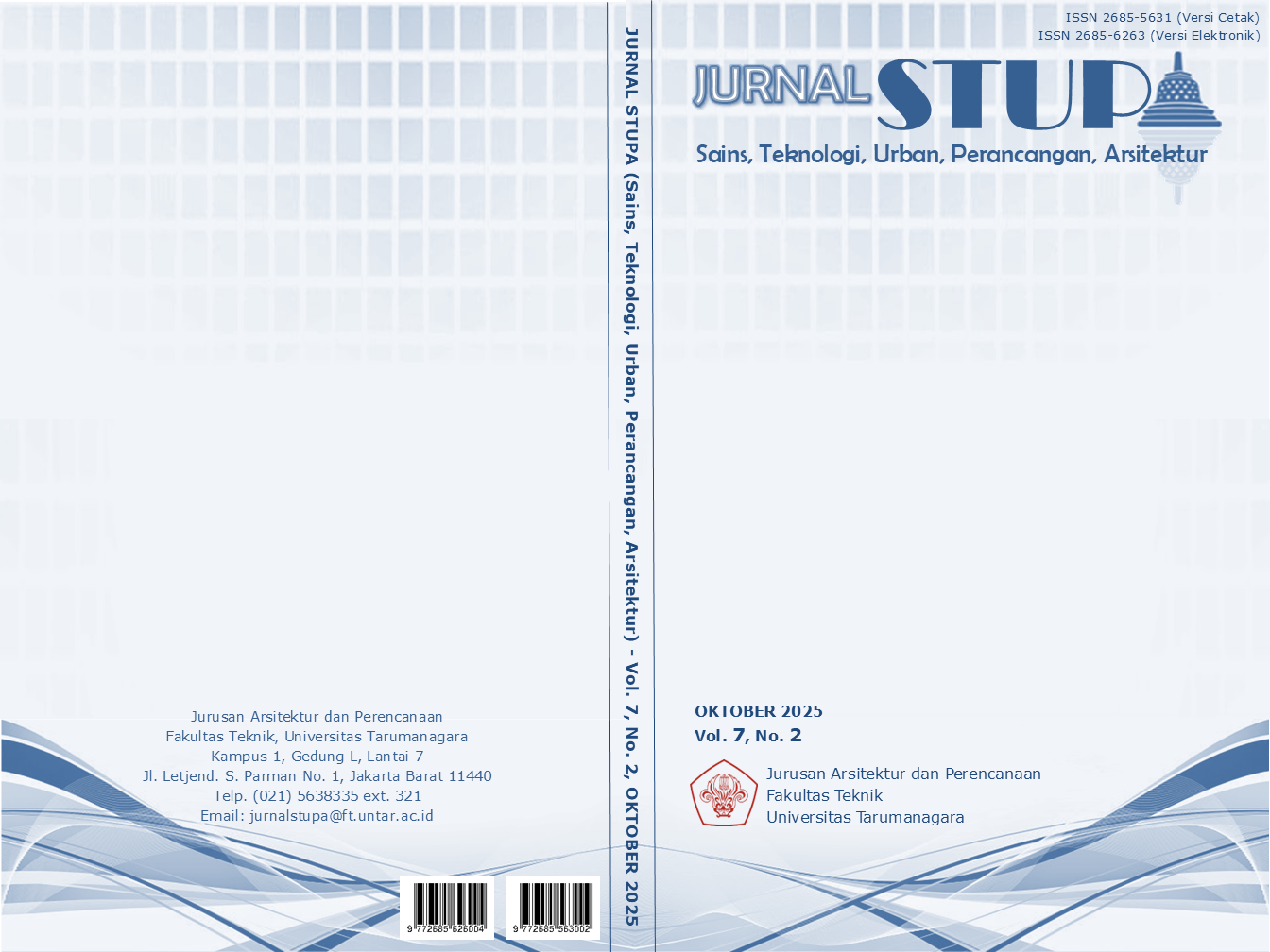KAMPUNG TUMBUH DAN PENGOLAHAN LIMBAH KERANG HIJAU: MENATA ULANG KAWASAN PESISIR KAMPUNG KERANG IJO
Main Article Content
Abstract
Kampung Kerang Ijo, located in the coastal area of Muara Angke, North Jakarta, is a traditional fishing settlement currently facing severe environmental and social crises. Issues such as land subsidence reaching 25 cm per year, water pollution, tidal flooding, and mangrove degradation significantly affect the residents’ quality of life. Additionally, poor infrastructure and spatial segregation further marginalize the community from equitable and sustainable urban development. This study aims to formulate a regenerative architectural strategy that responds to these intertwined challenges through the concepts of incremental kampung development and green mussel waste management. The research applies a qualitative descriptive method involving field observations, in-depth interviews with residents, and spatial-ecological analysis. The findings indicate that modular stilt housing with incremental growth potential effectively addresses the need for flexible living space while remaining adaptive to tidal and ground subsidence threats. Simultaneously, green mussel shell waste—previously considered environmental burden—shows potential as building material and organic fertilizer. These two strategies are integrated into a site plan that links domestic life, productive infrastructure, and restored mangrove zones. This regenerative design approach not only enhances ecological resilience and local economies but also promotes community ownership of space. Ultimately, it offers a replicable model for sustainable coastal housing that is culturally contextual and ecologically restorative.
Keywords: coastal; green mussel waste; growing kampung; regenerative; stilt housing
Abstrak
Kampung Kerang Ijo, yang terletak di kawasan pesisir Muara Angke, Jakarta Utara, merupakan kawasan permukiman nelayan tradisional yang saat ini menghadapi krisis lingkungan dan sosial. Penurunan tanah yang mencapai 25 cm per tahun, pencemaran air, banjir rob, dan degradasi hutan mangrove menjadi ancaman terhadap kualitas hidup masyarakat. Ditambah dengan buruknya infrastruktur dan segregasi spasial, kampung Kerang Ijo semakin terpinggirkan dari sistem perencanaan kota yang adil dan berkelanjutan di Jakarta. Penelitian ini bertujuan untuk merumuskan strategi arsitektur regeneratif yang dapat merespons kompleksitas berbagai persoalan tersebut melalui pendekatan kampung tumbuh dan pengolahan limbah kerang hijau. Metode penelitian menggunakan pendekatan deskriptif kualitatif dengan teknik observasi lapangan, wawancara mendalam dengan warga, serta analisis spasial dan ekologis. Temuan penelitian menunjukkan bahwa konsep rumah panggung modular dengan prinsip rumah tumbuh mampu menyesuaikan diri dengan kebutuhan ruang yang dinamis, sekaligus adaptif terhadap ancaman banjir rob dan penurunan tanah. Di sisi lain, limbah cangkang kerang yang selama ini mencemari lingkungan kampung ternyata memiliki potensi ekonomi dan daur ulang sebagai bahan bangunan dan pupuk organik. Kedua strategi ini diintegrasikan dalam rancangan kawasan yang menghubungkan ruang hidup, sistem produksi, dan zona restorasi mangrove. Pendekatan regeneratif ini diharapkan menjadi sebuah model perumahan pesisir yang tangguh, berkelanjutan, dan kontekstual dengan budaya serta ekologi lokal.
Article Details

This work is licensed under a Creative Commons Attribution-NonCommercial-ShareAlike 4.0 International License.
This work is licensed under a Jurnal Sains, Teknologi, Urban, Perancangan, Arsitektur/ STUPA Creative Commons Attribution-NonCommercial-ShareAlike 4.0 International LicenseReferences
Baper, S. Y., Khayat, M., & Hasan, L. (2020). Towards Regenerative Architecture: Material Effectiveness. International Journal of Technology, 722-731.
Guenther, R. (2019). Regenerative Architecture: Redefining Progress in the Built Environment. In D. Battisto, & J. Wilhelm, Architecture and Health: Guiding Principles for Practice (p. 16). New York: Routledge.
Habraken, N. (1999). Supports: An Alternative to Mass Housing. London: Routledge.
Kurokawa, K. (1994). The Philosophy of Symbiosis. London: Academy Editions.
Lyle, J. T. (1994). Regenerative design for sustainable development. New York: John Wiley & Sons.
Nika, J. W., Anisah, & S. M. (2019). PEMANFAATAN LIMBAH CANGKANG KERANG HIJAU DENGAN VARIASI. Jurnal Teknik Sipil, 10-18.
Petersson, J., & Soneryd, L. (2022). Defend, Retreat and Attack: Urban Waters and Valuation Practices. Water Alternatives, 175-192.
Raharjo, W. (2010). Speculative settlements: Built form/tenure ambiguity in kampung development. Melbourne: LAP LAMBERT Academic Publishing.



